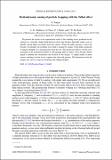| dc.contributor.author | Sungar, N. | |
| dc.contributor.author | Tambasco, Lucas | |
| dc.contributor.author | Pucci, Giuseppe | |
| dc.contributor.author | Saenz Hervias, Pedro Javier | |
| dc.contributor.author | Bush, John W. M. | |
| dc.date.accessioned | 2017-12-29T16:30:00Z | |
| dc.date.available | 2017-12-29T16:30:00Z | |
| dc.date.issued | 2017-10 | |
| dc.date.submitted | 2017-04 | |
| dc.identifier.issn | 2469-990X | |
| dc.identifier.issn | 2469-9918 | |
| dc.identifier.uri | http://hdl.handle.net/1721.1/112973 | |
| dc.description.abstract | We present the results of an experimental study of the standing waves produced on the surface of a vertically shaken fluid bath just above the Faraday threshold, when a row of equally spaced pillars protrudes from the surface. When the pillar spacing is twice the Faraday wavelength, the resulting wave field is marked by images of the pillars projected at integer multiples of a fixed distance from the row. This projection effect is shown to be analogous to the well-known Talbot or self-imaging effect in optics, and a Faraday-Talbot length is defined that rationalizes the location of the images. A simple model of point sources emitting circular waves captures the observed patterns. We demonstrate that the images may serve as traps for bouncing and walking droplets. | en_US |
| dc.description.sponsorship | National Science Foundation (U.S.) (Grant CMMI-1333242) | en_US |
| dc.description.sponsorship | National Science Foundation (U.S.) (Grant DMS-1614043) | en_US |
| dc.description.sponsorship | Natioanal Science Foundation (U.S.) (Grant CMMI-1727565) | en_US |
| dc.publisher | American Physical Society | en_US |
| dc.relation.isversionof | http://dx.doi.org/10.1103/PhysRevFluids.2.103602 | en_US |
| dc.rights | Article is made available in accordance with the publisher's policy and may be subject to US copyright law. Please refer to the publisher's site for terms of use. | en_US |
| dc.source | American Physical Society | en_US |
| dc.title | Hydrodynamic analog of particle trapping with the Talbot effect | en_US |
| dc.type | Article | en_US |
| dc.identifier.citation | Sungar, N. et al. "Hydrodynamic analog of particle trapping with the Talbot effect." Physical Review Fluids 2, 10 (October 2017): 103602 © 2017 American Physical Society | en_US |
| dc.contributor.department | Massachusetts Institute of Technology. Department of Mathematics | en_US |
| dc.contributor.mitauthor | Tambasco, Lucas | |
| dc.contributor.mitauthor | Pucci, Giuseppe | |
| dc.contributor.mitauthor | Saenz Hervias, Pedro Javier | |
| dc.contributor.mitauthor | Bush, John W. M. | |
| dc.relation.journal | Physical Review Fluids | en_US |
| dc.eprint.version | Final published version | en_US |
| dc.type.uri | http://purl.org/eprint/type/JournalArticle | en_US |
| eprint.status | http://purl.org/eprint/status/PeerReviewed | en_US |
| dc.date.updated | 2017-11-14T22:44:45Z | |
| dc.language.rfc3066 | en | |
| dc.rights.holder | American Physical Society | |
| dspace.orderedauthors | Sungar, N.; Tambasco, L. D.; Pucci, G.; Sáenz, P. J.; Bush, J. W. M. | en_US |
| dspace.embargo.terms | N | en_US |
| dc.identifier.orcid | https://orcid.org/0000-0002-6845-6552 | |
| dc.identifier.orcid | https://orcid.org/0000-0002-8091-5635 | |
| dc.identifier.orcid | https://orcid.org/0000-0002-9130-3589 | |
| dc.identifier.orcid | https://orcid.org/0000-0002-7936-7256 | |
| mit.license | PUBLISHER_POLICY | en_US |
